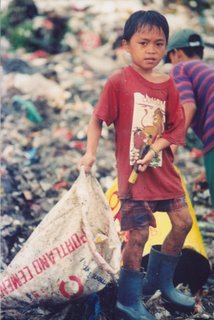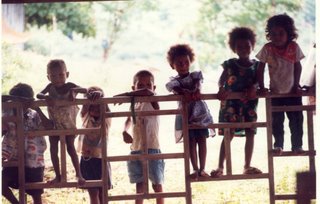 Either as "victims of abuse" or "in conflict with the law." That is according to a recent study made by the Center for Media Freedom and Responsibility (CMFR). The study, which was sponsored by the United Nations Children's Fund (UNICEF), was published in the June 2006 issue of the PJR Reports.
Either as "victims of abuse" or "in conflict with the law." That is according to a recent study made by the Center for Media Freedom and Responsibility (CMFR). The study, which was sponsored by the United Nations Children's Fund (UNICEF), was published in the June 2006 issue of the PJR Reports."According to the National Statistics Office, children below 18 years old comprise about 43.4 percent of the estimated population of 84 million Filipinos.
"At the same time, a United Nations Educational, Scientific and Cultural Organization (Unesco) country report dated October 2005 noted that the problems facing Filipino children today are 'considerable and pressing.'
 "It noted four core threats to the well-being of children related to health, nutrition, education, and protection. In fact, the country report ventures to say that out of 100 Filipino children: eight will most likely die before their fifth birthday, 30 will suffer from malnutrition, 26 will fail to be immunized against basic childhood diseases, 19 will lack access to safe drinking water and 40 to adequate sanitation while more than 10 suffer from some physical or mental disability or developmental delay, and 17 will never go to school.
"It noted four core threats to the well-being of children related to health, nutrition, education, and protection. In fact, the country report ventures to say that out of 100 Filipino children: eight will most likely die before their fifth birthday, 30 will suffer from malnutrition, 26 will fail to be immunized against basic childhood diseases, 19 will lack access to safe drinking water and 40 to adequate sanitation while more than 10 suffer from some physical or mental disability or developmental delay, and 17 will never go to school."Yet, despite these pressing issues, news items about children revolve around only two themes: children as 'victims of abuse' or 'in conflict with the law'," wrote Rachel E. Khan and Elena E. Pernia in their story on the CMFR study on children.
CMFR study noted that reporters and editors should be conscious that "children are not miniature adults and have greater awareness of the impact a traumatic event can have on children." It also recommended that the Department of Justice (DOJ) should be more active in providing journalists with copies of its guidelines in covering children, especially those covering the Department of Social Welfare and Development (DSWD) and those working in the community press.
 "At the same time, there is a need to expand the coverage on children to 'good news' stories and those that tackle issues affecting the children’s quality of life. Instead of straight news stories that can sometimes be reported without sensitivity to the child, journalists should explore feature stories that tackle children’s issues with greater depth, help create an awareness of a problem and possibly propose a solution," the CMFR report said.
"At the same time, there is a need to expand the coverage on children to 'good news' stories and those that tackle issues affecting the children’s quality of life. Instead of straight news stories that can sometimes be reported without sensitivity to the child, journalists should explore feature stories that tackle children’s issues with greater depth, help create an awareness of a problem and possibly propose a solution," the CMFR report said.Read Khan and Pernia's article in the PJR Reports here.
To look at the study in the CMFR website, click here. You can also look at the report by clicking here.
Download Khan's presentation on the study here. She presented the study in a training seminar for media practitioners on covering children. For more information about the seminar, click here. Khan also has a post on the seminar in her blog.
(Pictures on this post from Lito Ocampo)





No comments:
Post a Comment